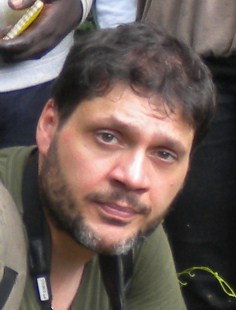Dr Christos Astaras
Alumni
Originally from Thessaloniki, Greece, I obtained a BA in Conservation Biology from Middlebury College, Vermont, USA (1999) and subsequently a Masters in Environmental Studies from York University, Toronto, Canada (2002). For my doctoral studies at Georg-August University of Göttingen, Germany, I spent 2006-2008 in the rainforest of Korup National Park, Cameroon, studying the ecology and conservation status of the endangered drill monkey (Mandrillus leucophaeus).
I joined the WildCRU team in 2010 as a researcher and course coordinator/lead tutor of the Recanati-Kaplan Centre Post Graduate Diploma in International Wildlife Conservation Practice. My main research interests focus on developing new conservation tools (often based on novel applications of existing technologies) to improve law enforcement and wildlife monitoring within and in the periphery of protected areas.
Since 2013, I have been the project coordinator and co-principal investigator (PI) of a Darwin Initiative project (Ref# 20-012) which piloted the use of passive acoustic monitoring (PAM) in Afrotropical rainforests as a way of improving the capacity of protected areas to effectively design and evaluate anti-poaching activities based on robust field evidence. Using a grid of acoustic sensors, we have collected >3 years of continuous data on gunshot records in a central area of Cameroon’s Korup National Park providing unprecedented spatiotemporal resolution on gun hunting patterns. That data is currently examined in conjunction with concurrent bushmeat consumption, bushmeat seller and hunter surveys in the region and records of game guard patrols. In 2014, we established a similar grid within the nearby Rumpi Hills Forest Reserve as part of a US Fish and Wildlife Service project (Ref# F14AP00503) of which I am a co-PI. Together with my collaborators in these projects from James Madison University, Cornell University and the SAVE Wildlife Conservation Fund, I assist rolling out the use of PAM in more protected areas both in tropical and temperate climates, including my native Greece. You can read more about our preliminary findings on gun hunting monitoring using bioacoustics by visiting our Darwin Initiative project’s website and reading the annual reports at Darwin Initiative’s page.
Furthermore, I am/have been involved in several smaller projects examining the drivers and potential mitigation of human-wildlife and especially carnivore conflict (e.g. wolf/tiger/leopard livestock attacks, African forest elephant crop-raiding), carnivore population monitoring and conservation (e.g. European wild cat, West African lion, jaguar), and primate conservation (drill, Preuss’s red colobus).
Projects
Links:
- Darwin Initiative (Ref# 20-012 project reports)
- Eavesdropping on Cameroon’s poachers (Mongabay.com article)
- The rare primates of “Drill Ranch” (DW article)
- Diploma Website
- Diploma alumni forum
Selected Publications
Astaras, C., Linder, J.M., Wrege, P., Orume, R.D., Macdonald, D.W. (submitted). Passive acoustic monitoring as a law enforcement monitoring tool for Afrotropical rainforests. Frontiers in Ecology and the Environment.
Rostro-Garcia, S., Tharchen, L., Abade, L., Astaras, C., Cushman, S., Macdonald, D.W. (2016). Scale dependence of felid predation risk: Identifying predictors of livestock kills by tigers and leopards in Bhutan. Landscape Ecology 31:1277-1298.
Morgan, B., Abwe, E., Dixson, A., Astaras, C. (2013). The distribution, status and conservation outlook of the drill (Mandrillus leucophaeus) in Cameroon. International Journal of Primatology 34:281-302.
Ting, N., Astaras, C., Gail, H., Honarvar, S., Corush, J., Burrel, A., Phillips, N., Morgan, B., Gadsby, E., Raaum, R., Roos, C. (2012). Genetic signatures of a demographic collapse in a large-bodied forest dwelling primate (Mandrillus leucophaeus). Ecology and Evolution 2:550-561.
Astaras, C., Krause, S., Mattner, L., Rehse, C., Waltert, C. (2011). Associations between the drill (Mandrillus leucophaeus) and sympatric primate species in Korup National Park, Cameroon. American Journal of Primatology 73:127-134.
Astaras, C., Waltert, M. (2010). What does seed handling by the drill tell us about the ecological services of terrestrial cercopithecines in African forests? Animal Conservation 13:568-578.
Astaras, C., Mühlenberg, M., Waltert, M. (2008). Note on drill (Mandrillus leucophaeus) ecology and conservation status in Korup National Park, Southwest Cameroon. American Journal of Primatology 70:306-310.






